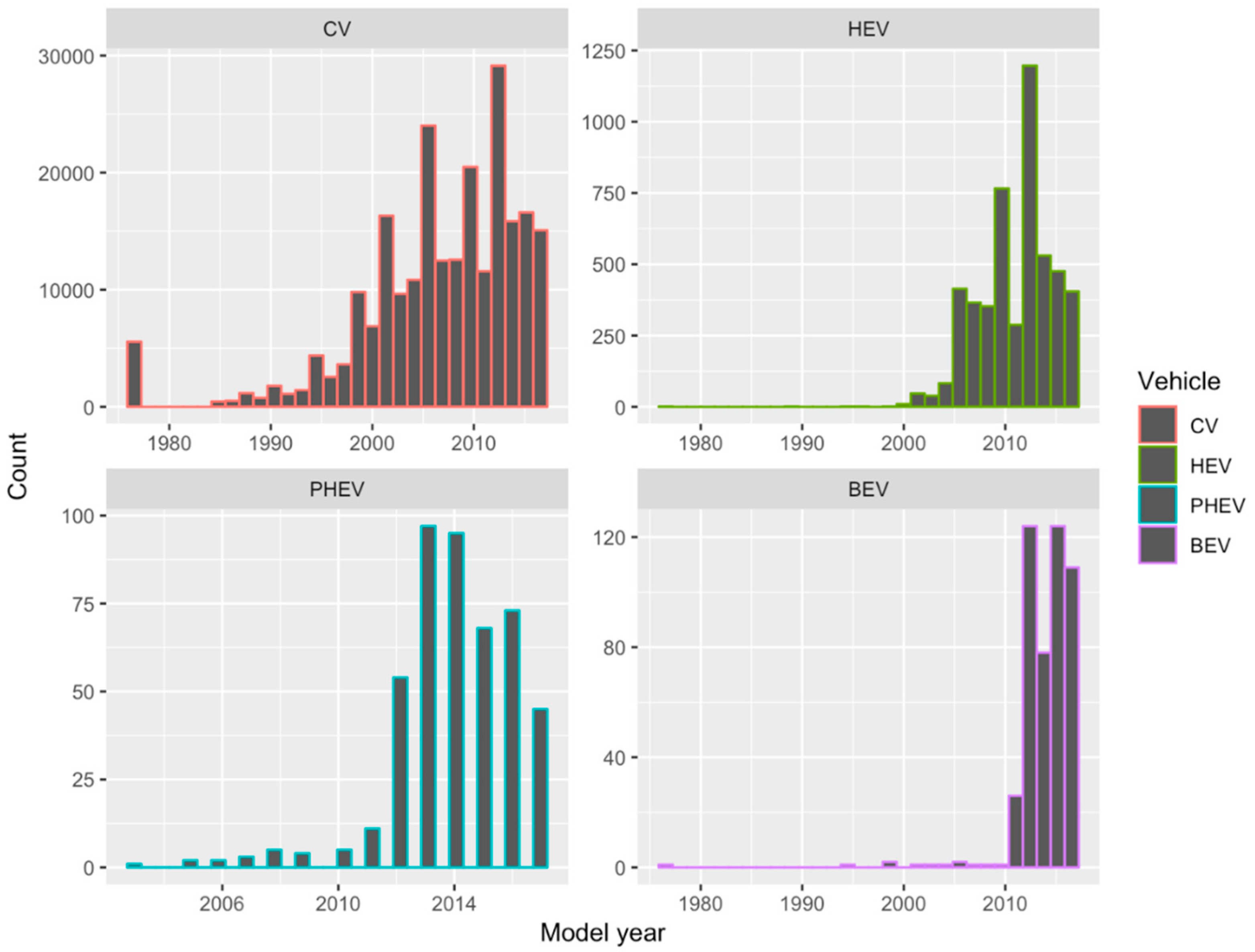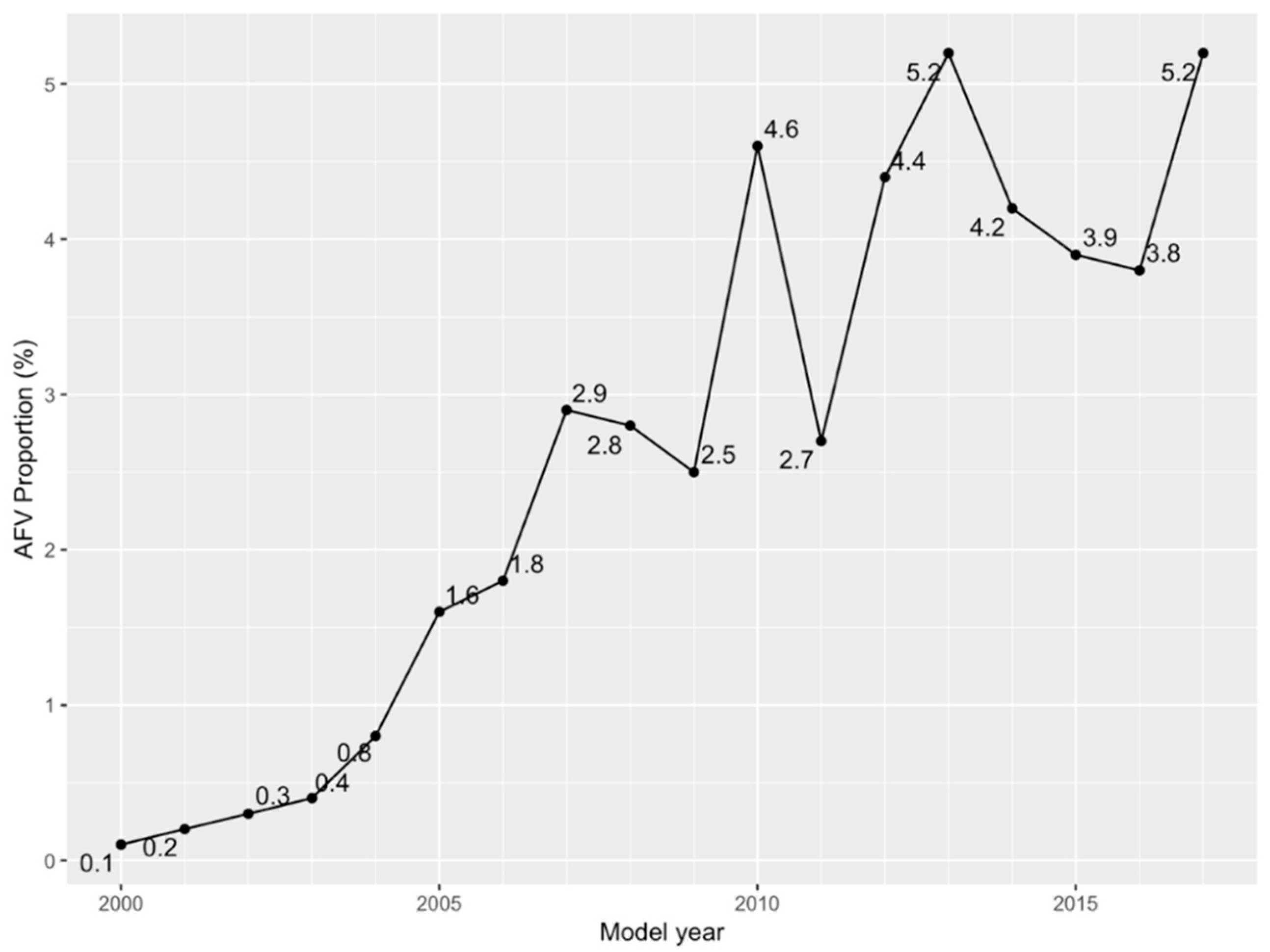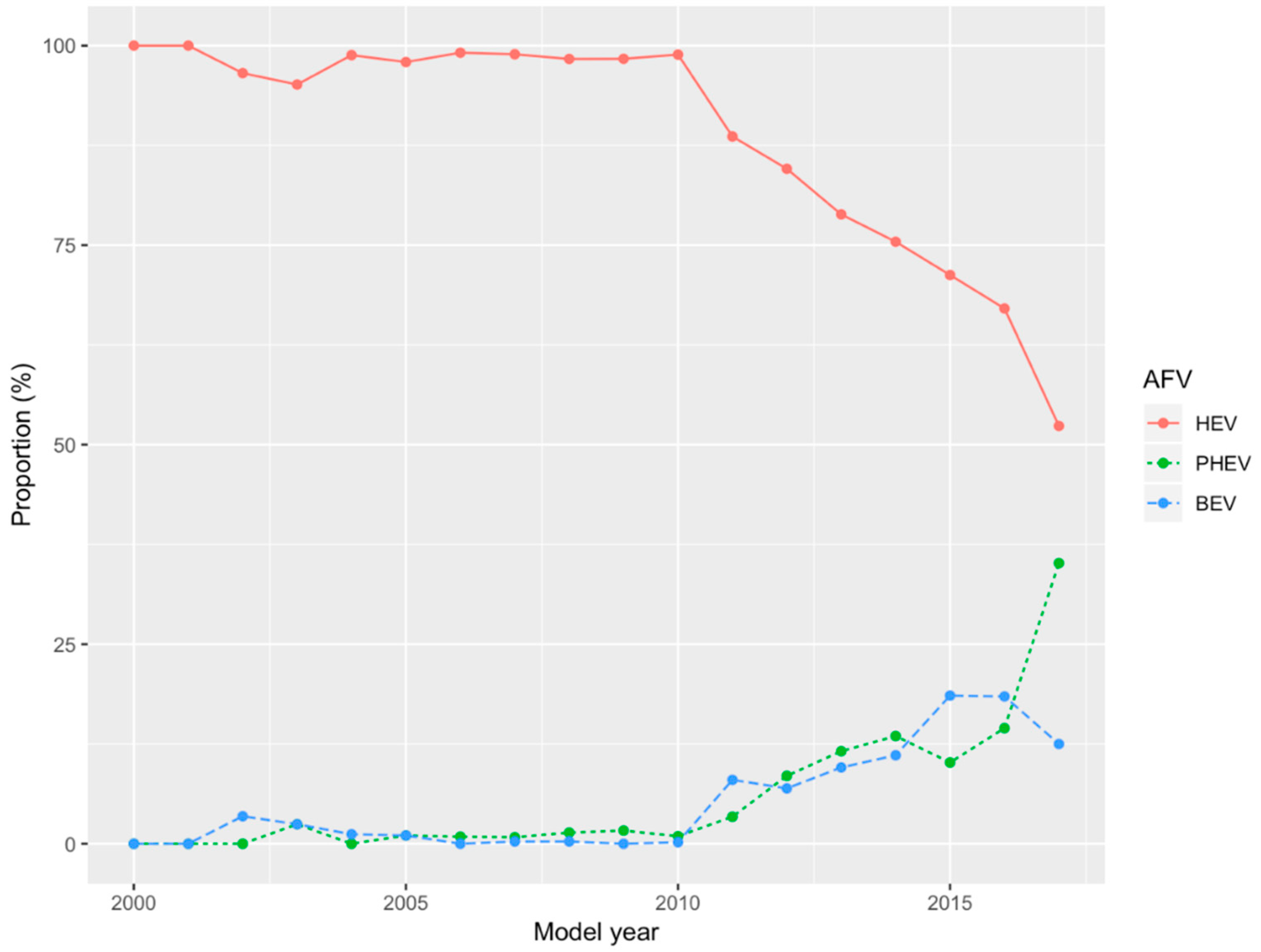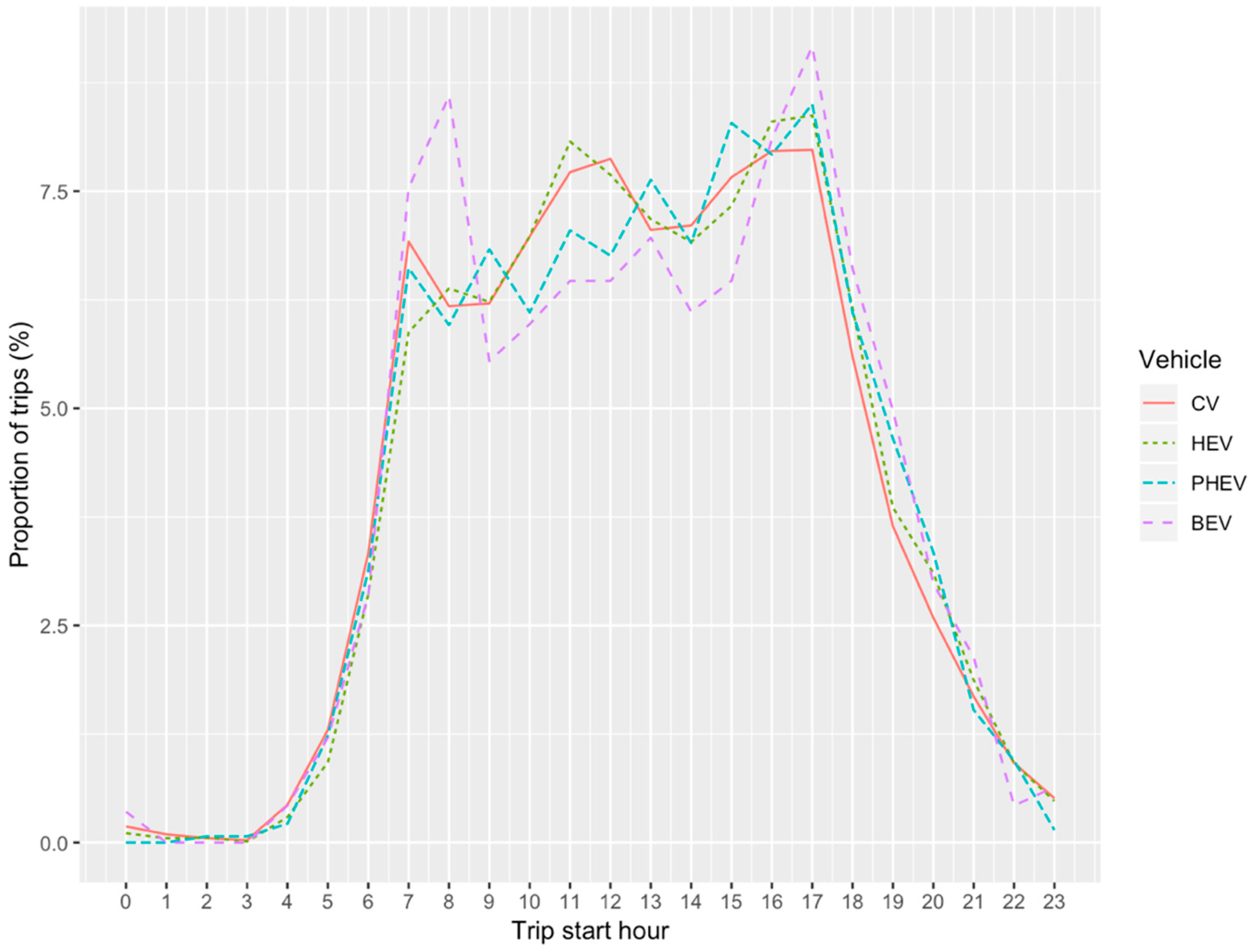1. Introduction
Transportation is one of the major energy consumers and emission sources. In the United States (U.S.), transportation consumed 29% of energy in 2017 [
1] and emitted 28% of greenhouse gas (GHG) in 2016 [
2]. Due to concerns involving fuel price rises, pollution and global warming, regulations on fuel economy and emissions of vehicles have been increasingly stringent in the past few decades, which has been prompting automakers to develop more energy-efficient and emission-reducing vehicles. One important solution is to develop hybrid electric vehicles (HEVs). Compared to conventional vehicles (CVs) with internal combustion engine (ICE), a hybrid electric vehicle (HEV) combines an ICE system with one or more electric motors that use energy stored in batteries, thus achieving a better fuel economy and low emissions [
3]. The batteries are usually charged by regenerative braking and ICEs. Although the concept of HEVs was proposed as early as 1901 [
4], they were not commercially available in large scale until the release of the Toyota Prius in Japan in 1997, followed by the Honda Insight in 1999 [
5]. In 2002, Lave and MacLean compared the second generation of Toyota Prius to the conventional ICE—Toyota Corolla, where Prius was proved to have lower pollutant and carbon dioxide emissions and a better fuel economy than the Corolla [
6].
With technological advances, plug-in hybrid electric vehicles (PHEVs) and battery electric vehicles (BEVs) have also been developed and made widely available in the auto market in the past decade. PHEVs also combine the battery-electric vehicle technology with an ICE system, but they generally have larger battery packs than HEVs, and thus can travel for some distance just using electricity [
7]. Meanwhile, their batteries can also be charged from external chargers in addition to using energy from regenerative braking and the ICEs. PHEVs could significantly improve fuel economy over standard HEVs [
8]. BEVs only use battery packs to store the electricity to power them. Their batteries are usually charged by plugging vehicles into external electric power sources [
9], thus fast charging may apply. BEVs generally have shorter ranges than CVs, but their major advantage is zero emissions at the point of use [
9]. In the past two decades, HEVs, PHEVs and BEVs have become non-ignorable players in the auto market. In the U.S., the total sales of HEVs, PHEVs and BEVs reached up to 565,930 units in 2017 [
10,
11], occupying about a 3.28% market share [
12]. Compared with CVs, HEVs, PHEVs and BEVs belong to the category of alternative fuel vehicles (AFVs), which also includes hydrogen fuel cell vehicles (HFCVs), compressed natural gas (CNG) vehicles, solar vehicles, biodiesel vehicles, and so on. However, currently, their market shares are still very small compared with HEVs, PHEVs and BEVs in the U.S.
Accompanying the arrival of AFVs, numerous studies have been conducted to explore their characteristics from the perspectives of vehicle technology [
13], environmental protection [
14], charging infrastructure [
15,
16], market penetration rate [
17], consumer acceptance [
18,
19,
20,
21], and so on. However, due to the short history of AFVs, especially for PHEVs and BEVs, in the auto market, there is still a lack of knowledge on the characteristics of ownership and usage of AFVs in practice. These features can be represented by three questions: What AFVs are used now? Who owns them? How are they used? This knowledge is critical for all stakeholders in the realm of AFVs. They can help automakers to determine AFV design and sales, policymakers to formulate AFV purchase incentives & perks, transportation agencies to construct AFV-compatible infrastructure and consumers to determine whether to adopt AFVs or not. For example, knowing about the demographic and socio-economic features of AFV owners is greatly helpful for automakers in setting prices and promotion strategies, while identifying daily travel distances of BEVs is critical for public utilities agencies to determine the layout of charging stations.
The National Household Travel Survey (NHTS) is a periodic national survey conducted in the U.S. to assist transportation planners and policy makers who need comprehensive data on travel and transportation patterns of the U.S. [
22]. Data is collected on the trips of households and individuals for the surveyed households over a 24-h period. The questionnaire includes purpose of the trip, means of transportation, travel time of trip, and time of day/day of week. This data is collected for all trips, modes, purposes, trip lengths and all areas of the country, urban and rural. The NHTS was conducted in 1969, 1977, 1983, 1990, 1995, 2001, 2009, and 2017, respectively. In the 2009 NHTS, AFV information was first collected, where each vehicle in the household with a model year of 2002 or newer was asked whether it was a hybrid or alternate fuel use vehicle [
23]. In the 2017 NHTS [
24], respondents were required to further indicate AFV types, including biodiesel, PHEV, BEV, HEV and other fuels. Therefore, the 2017 NHTS data is the 1st NHTS data, which might be used in analyzing the ownership and usage characteristics of AFVs in detail. Numerous studies have demonstrated the value of the NHTS data in exploring a variety of transportation research topics, such as ride-hailing [
25], walking and cycling [
26], travel patterns of older people [
27,
28], immigrants [
29] and students [
30], and so on. There are also some exploratory studies involved in speculating and forecasting usage features of AFVs with NHTS data, mainly using the 2009 NHTS data [
31,
32,
33,
34,
35,
36,
37] and the 2001 NHTS data [
38,
39,
40,
41]. However, none of them were able to identify the actual ownership and usage features of HEVs, PHEVs and BEVs due to unavailability of AFV information in former NHTSs. In addition, some studies have tried to analyze travel patterns of AFVs with the data of the California Household Travel Survey (CHTS) conducted by the California Department of Transportation during January 2012 through January 2013 [
42,
43,
44]. However, considering the fast development of AFVs, the CHTS data might not be able to reflect the current status quo of AFVs. For example, the Model S sedan from Tesla is now one of the most popular BEVs [
10], but it was not released until 22 June 2012 [
45]. Thus, the CHTS data were not expected to include many Model S vehicles. In addition, the CHTS data were only collected in California. Considering the huge differences of economy, weather, terrain, oil price and charging infrastructure across states in the U.S., the findings from the CHTS might not be generalized to other states or the national level. Additionally, some studies tried to use the naturalistic driving data to analyze travel patterns of drivers [
46,
47,
48], but most of them did not specifically focus on AFVs in vehicle selection.
Therefore, this study focuses on using the 2017 NHTS data to obtain basic ideas of actual ownership and usage characteristics of AFVs in the U.S. The paper is organized as follows.
Section 2 introduces the 2017 NHTS data.
Section 3.1 presents vehicle features of AFVs.
Section 3.2 explores the ownership features of AFVs in terms of main drivers and households.
Section 3.3 analyzes travel patterns of AFVs.
Section 4 gives conclusions and areas for discussion.
2. Materials
The 2017 NHTS was conducted by the Federal Highway Administration, U.S. Department of Transportation from April 2016 through to April 2017. The 2017 NHTS collected vehicles from all 50 states and the District of Columbia of the U.S. It includes the core national samples plus samples from 13 state and local planning agencies from around the country [
24]. Researchers collected data from roughly 130,000 households and 275,000 persons in the U.S., sampled based on postal address lists. Each participating household reported all travels by household members on a randomly assigned 24-h single “travel day”. They were assigned travel days for all 7 days of the week, including all holidays.
The 2017 NHTS data consists of four datasets: household, person, trip, and vehicle [
24]. Hybrid vehicle information can be retrieved from two fields of the vehicle dataset: fuel type and hybridization of the vehicle. For fuel type, subjects were asked to report the type of fuel used by each household vehicle with choices being “I don’t know”, “I prefer not to answer”, “gas”, “diesel”, “hybrid, electric or alternative fuel”, and “some other fuel”. They were also asked type of hybrid vehicle for vehicles that were reported to use “hybrid, electronic or alternative fuel” with choices being “not ascertained”, “I don’t know”, “appropriate skip”, “biodiesel”, “plug-in hybrid”, “electric”, “not plug-in hybrid”, and “some other fuel”. Based on specific keywords, household, person and trip information linked to vehicles can be retrieved.
By vehicle type, vehicles are reclassified into car, van, sport utility vehicle (SUV), pickup truck, and others; by fuel type, they are divided into CV, HEV, PHEV, BEV, and others. The composition of vehicles by vehicle type and fuel type can be seen in
Table 1.
It can be found that:
AFVs only occupy 2.5% of total surveyed vehicles, which implies that there is still a long way to go for AFVs after nearly twenty years of development.
Most AFVs belong to HEVs, PHEVs and BEVs. HEVs has the largest share (77.9%), whereas PHEVs and BEVs only have very small shares (7.5% and 9.5%). That is, HEVs still currently dominate the AFV market as a whole.
AFVs vary a lot by vehicle type. Most AFVs are cars, whereas very few of them are SUVs, vans and pickup trucks, which however occupy nearly half of total surveyed vehicles. Thus, it implies that development of alternative fuel SUVs, vans and pickup trucks should be taken into account for automakers in their future plan, especially plug-in hybrid electric and battery electric SUVs, vans and pickup trucks.
Considering automobiles/cars/station wagons (named as “cars”), vans, SUVs and pickup trucks are typical household vehicle types for daily travel in the U.S., the following analysis will focus on analyzing cars, vans, SUVs and pickup trucks of CV, HEV, PHEV and BEV. These vehicles occupy 94.4% of total surveyed vehicles, and 92.3% of total surveyed AFVs. Thus, the data are thought to be big enough to represent the whole sample.
4. Conclusions and Discussion
In the past two decades, AFVs, mainly consisting of HEVs, PHEVs and BEVs have received much attention and made much progress in commercialization under the context of reducing fossil fuel consumption and emission in transportation. Compared to CVs driven only by ICEs, these AFVs are equipped with either extra rechargeable battery packs besides ICEs or pure rechargeable battery packs. Due to the generally high purchase costs, many policies of purchase incentives and perks have been formulated to promote AFV sales. However, after nearly two decades of development for HEVs and one decade for PHEVs and BEVs, there is still a lack of understanding of the actual ownership and usage characteristics of AFVs at the national level of the U.S. In particular, considering the impending expiration of electric vehicle tax credits for some models in 2018 [
61], it is time to review the state of the art of AFV usages in the U.S. Based on the latest 2017 NHTS data of the U.S., this paper focuses on answering three basis questions involving in ownership and usage of AFVs: What AFVs are running in the U.S.? Who owns them? How are they used? The significance of the 2017 NHTS is that it is the first NHTS to collect specific information of HEVs, PHEVs and BEVs. Besides, both the wide data collection range covering all 50 states and the Districted of Columbia of the U.S., and the small average ages of HEVs (6.0 years), PHEVs (3.2 years) and BEVs (3.1 years) suggest that the 2017 NHTS data might be one of the best available datasets to give answers to these questions. The findings from this study are thought to be updated, credible and reliable.
It is found that although the AFV adoption has been increasing, AFVs still only occupy a small share (less than the 5%) of the annual auto market in the U.S, and they show very slow recent increases. For the AFV market, the share of PHEVs & BEVs has risen to nearly 50% in 2017 from nearly zero in 2010, indicating a major growth prospective. In terms of vehicle types, nearly 90% of surveyed AFVs are cars. However, considering the major presences of vans, SUVs and pickup trucks in the auto market of the U.S., automakers may focus more on developing alternative fuel vans, SUVs and pickup trucks in the future. Besides, the AFV market is also dominated by few vehicle brands. In terms of vehicle ownership, the median annual household incomes of CVs, HEVs, PHEVs and BEVs are $75,000, $100,000, $150,000 and $200,000, respectively, which corroborates that income is one of major factors influencing adopting AFVs. Besides, AFV households are more likely to live in urban areas, especially large metropolitan areas, where charging stations are expected to be well-developed. These findings confirm that continuously lowering ownership costs and building more charging infrastructure are critical for further promoting AFV development. Meanwhile, in regards to vehicle main drivers, the proportions of old people (≥65) driving PHEVs and BEVs are only 26.3% and 19.3%, respectively, much lower than that of CVs. In terms of travel patterns, PHEVs and HEVs have very close mean and the 85th percentile daily trip distances and daily trip durations, which are significantly larger than those of CVs and BEVs, whereas BEVs have the smallest indicator values. Since more than 85% of daily travels last less than 93.5 km in distance and 125 min in duration for CVs, BEVs might still be capable of replacing CVs for meeting most travel demands. However, for extremely long-distance travel demands, AFVs are used far less than CVs, indicating there may be still an underlying concern to the endurance of AFVs for customers. Therefore, the development of battery technology to increase the endurance is critical for encouraging more people to adopt AFVs to replace CVs completely in the future.
4.1. Implications for AFV Stakeholders
The findings from this paper can help a number of stakeholders to fully identify the issues of the current AFV market from the perspectives of vehicle, people and usage, and provide many instructive insights to the future AFV development. Firstly, the paper indicates that the developments of AFVs seem to encounter a bottleneck in the U.S., as their market share does not have obvious increases since 2010, although people are expected to have more knowledge of AFVs over time. However, considering the increasing shares of PHEVs and BEVs in this time period, this means that the future AFV development may greatly depend on PHEVs and BEVs rather than HEVs in the U.S. Automakers and policymakers may adjust their development strategies based on this trend. Furthermore, they may also want to figure out the most attractive features of PHEVs and BEVs to consumers: high performance, technological innovation, environment protection [
62], or low running costs? Thus, they can formulate customized sales and financial incentive policies.
A second implication is that it gives the household income indicators of owning AFVs in the U.S. Although income has been well-known as a major factor influencing the AFV adoption and many studies obtained some data on this area through questionnaires conducted on small scales, there is a lack of such information at the national level for the U.S. The income information related to AFVs presented in this study may help automakers to more accurately search for potential AFV customers with lower costs and formulate targeted sales policies. It may also instruct policymakers to design more effective financial incentive policies, as the current incentive policy is found to be misplaced for many BEV customers and the income cap or vehicle price eligibility gap-based incentives might be more appropriate [
62]. This information is also a good reference for customers to determine whether it is a good time for them to adopt AFVs.
Finally, the travel pattern indicator values presented in this paper, especially the 85th percentile daily trip distance and the 85th percentile daily trip duration, may help automakers to determine the capacity of AFV batteries. Batteries with high capacity are usually costly. It is thought that appropriate batteries should be capable to meet most travel demands with the least costs. Additionally, while aiming for taxi/ride-sharing vehicles which have special requirements on battery capacity, the maximum indicator values might be consulted to design AFVs for taxi/ride-sharing purposes. This information might also be used by public utility agencies to determine the number, location, layout and size of charging stations.
4.2. Future Studies
This study concentrates on making a macroscopic analysis on the status quo of AFVs used in practice in the U.S., whereas future studies might be conducted in many aspects to get more details. Firstly, policy is proved to have great effects on the AFV adoption in numerous studies. In the U.S., although there are uniform federal policies, the state-level AFV purchase incentives vary a lot amongst states. Future researchers may want to explore how these policies influence the adoption of AFVs. Secondly, fuel price is another factor which might influence AFV adoption. In the past decade, fuel prices had very major fluctuations due to many events, such as the 2008 economic recession. Researchers may want to identify the influence of fuel price on the AFV adoption, which would be helpful in figuring out the long-term AFV adoption trend under the context of oil production. Thirdly, with the increase of AFVs, AFV crashes have also increased. However, different from CVs, it is found that AFV-related crashes provide many new challenges from collision types to salvation methods due to the presence of batteries. It is time to know about the features of AFV crashes, whether and how AFVs would affect traffic safety as a whole. Fourthly, a huge part of AFVs are adopted in public transportation and government agencies. These vehicles are expected to be very different from private vehicles in many aspects, such as vehicle design, battery capacity, incentives, travel pattern, and so on. Future studies may combine these vehicles and private vehicles to get a full understanding on how AFVs is reshaping the transportation mode of this country. Fifthly, the lifespan of a hybrid vehicle battery is usually 5 to 10 years [
63]. As is shown in the paper, PHEVs and BEVs had significant appearances since 2010 in the U.S., which means these vehicles may start to have batteries replaced on a large scale in practice. Considering the high battery replacement costs and battery recycling challenges, it is time to explore whether and how the practical battery replacement experiences influence customers’ attitudes to adopt PHEVs and BEVs. Finally, HFCVs have gained much attention recently [
64,
65]. HFCVs are famous for having zero emissions at point of use, fast refueling and a high driving range [
66]. Although their current market share is insignificant (as of February, 2019, only 6558 HFCVs were sold in the U.S. [
67]) due to high purchase prices, high fuel cost and limited refueling infrastructure [
68,
69,
70], HFCVs are thought to be economically competitive with technological advancements and more hydrogen refueling stations being built in the future [
71]. Their market share is expected to increase to 21% in North America by 2040 [
72]. Unfortunately, the information of HFCVs was not explicitly collected in the 2017 NHTS. Thus, HFCVs are not taken into account in this study. However, considering the enormous potential of HFCVs, it is also important to identify ownership and usage features of HFCVs. Future studies might consider combine the NHTS data with other specific HFCV survey data to make such analysis. It should be noted that currently, 40 out of total 45 hydrogen fueling stations in the U.S. are located in California [
73]. Thus, only the NHTS data of California might be used in these analyses.











